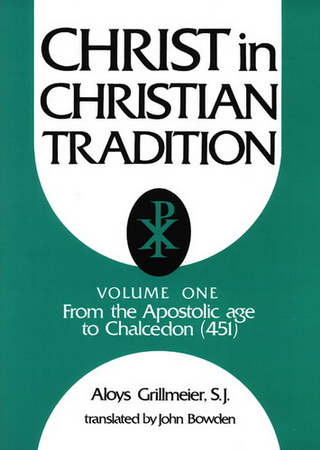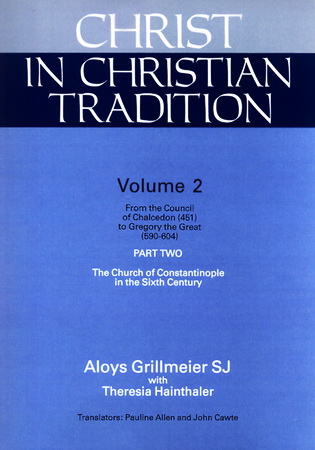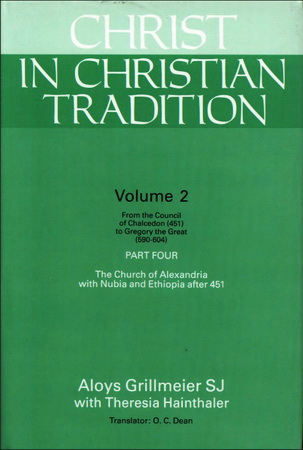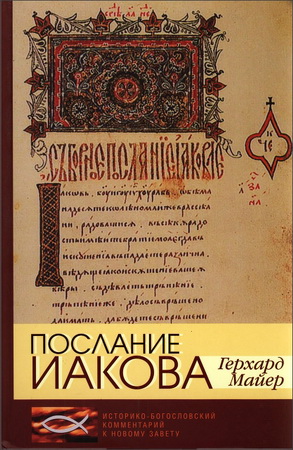
Grillmeier - Christ in Christian Tradition - Грильмайер - 4 тома

Christ in Christian Tradition
Для тех кто знает, это вообще хит сезона. Ее нет ни в русском, ни в английском и-нете в оцифрованном виде. Мы ее сами купили! На английском языке.
***
В научной литературе есть работы, без знакомства с которыми невозможно получить полное представление о предмете. Такие труды называются классическими (причем, без всяких кавычек) в той или иной области гуманитарных знаний. В области истории христологических споров такой работой, безусловно, является труд немецкого ученого и кардинала Алоиса Грильмайера.
Серия книг кардинала Грильмайера, называемая часто просто "JCGK" (Jesus der Сhristus im Glauben der Kirche, "Иисус Христос в церковном вероучении") или даже просто "Грильмайер" давно стала классикой патрологии, так что можно сказать, не сильно преувеличивая, что никакая патрологическая работа с источниками II—VI вв. практически немыслима без использования этого грандиозного труда.
Первые два тома были написаны непосредственно кардиналом Грильмайером, а последующие уже издаются при участии Терезии Хайнталер ученицы и продолжателя дела знаменитого историка, скончавшегося в 1998 году, по его записям. В работе задействован большой массив первоисточников на греческом, латинском, сирийском, коптском и армянском языках.
К сожалению, имя этого известного в научных кругах богослова и патролога мало известно широкому кругу русскоязычных читателей.
Работы Грильмайера являются образцами немецкой научной скрупулезности, в них представлен обзор и анализ всех доступных источников. Знакомство с фундаментальным трудом кардинала Грильмайера вне всяких сомнений позволит читателю значительно расширить свой кругозор в области становления и развития христианской керигмы в области христологии. Представляем нашим читателям первые два тома этого фундаментального исследования.
***
Разумеется, христологическая дискуссия за последние годы продвинулась вперед и была обогащена большим числом других отдельных исследований. К сожалению, здесь не представляется возможным перечислить все или тем более оценить их. Тем не менее, необходимо отметить значительный вклад, внесенный грандиозным трудом Алоиза Грильмайера «Иисус Христос в вере Церкви».
Вальтер Каспер (из работы “Иисус Христос”)
Christ in Christian Tradition - Aloys Grillmeier - Иисус Христос в церковном вероучении - Алоис Грильмайер - 4 тома
- Volume One: From the Apostolic Age to Chalcedon (451)
- Volume Two: From the Council of Chalcedon (451) to Gregory the Great (590–604)
- Part One: Reception and Contradiction. The development of the discussion about Chalcedon from 451 to the beginning of the reign of Justinian
- Part Two: The Church of Constantinople in the sixth century
- Part Four: The Church of Alexandria with Nubia and Ethiopia after 451
Aloys Grillmeier - Christ in Christian Tradition - Volume One - From the Apostolic Age to Chalcedon (431) - Autor's Preface
This book is a full revision of my article 'Die theologische und sprachliche Vorbereitung der christologischen Formel von Chalkedon,' which was published in A. Grillmeier‑H. Bacht, Das Konzil von Chalkedon I (Würzburg 1951, 19592, 19633), 5–202. The original plan, suggested by the Rev. J. S. Bowden, was simply for a translation of this study and an expansion of the bibliographical notes on the basis of the corrected reprint of 1959. Mr. Bowden also took upon himself the troublesome task of translation, which steadily increased as the scope of the revision enlarged. I am especially grateful for his help.
I have been particularly concerned to describe the transition from the Apostolic Age to the time of the emergence of the christological problem proper, i.e. to give an account of the christological development of the second century. This calls for still greater consideration, and more adequate treatment than can be offered here. On the whole, I have tried to understand and to describe each stage of the development in its own particular character and to avoid introducing later dogmatic concepts. In my opinion, however, this does not exclude the stressing of the rudiments of later developments where these rudiments are really present.
As far as is possible, this investigation is to be continued, first of all as far as the end of the patristic period; the preliminary work is already quite far advanced.
My thanks are also due to the publishers, A. R. Mowbray & Co. Ltd., and to their Chairman, Mr. Neville Hilditch, who undertook to publish the work and has waited with great patience for its completion.
Finally, I should like to take this opportunity of expressing my gratitude to Dr. F. L. Cross and the Oxford International Conference on Patristic Studies, to which this work is much indebted.
The Author
Frankfurt, May 24th, 1964
 CHRIST IN CHRISTIAN TRADITION - VOLUME TWO - From the Council of Chalcedon (451) to Gregory the Great (590–604) - Part One - Reception and Contradiction The development of the discussion about Chalcedon from 451 to the beginning of the reign of Justinian
CHRIST IN CHRISTIAN TRADITION - VOLUME TWO - From the Council of Chalcedon (451) to Gregory the Great (590–604) - Part One - Reception and Contradiction The development of the discussion about Chalcedon from 451 to the beginning of the reign of Justinian
by ALOYS GRILLMEIER, S. J.
translated by PAULINE ALLEN & JOHN CAWTE
MOWBRAY LONDON & OXFORD
First published in Great Britain in 1987 by A. R. Mowbray & Co. Ltd, Saint Thomas House, Becket Street, Oxford, OXI ISJ
Printed in Great Britain by The Bath Press, Avon
British Library Cataloguing in Publication Data
Grillmeier, Aloys
Christ in Christian tradition. Vol. 2 Pt. 1
I. Jesus Christ
I. Title II. Jesus der Christus im Glauben der Kirche. English 232 BT202
ISBN 0–264–66017–X
CHRIST IN CHRISTIAN TRADITION - Volume Two Part One - Reception and Contradiction The development of the discussion about Chalcedon from 451 to the beginning of the reign of Justinian - PREFACE
In spite of significant monographs on the subject, post‑Chalcedonian christology of the patristic period still cries out for a comprehensive elucidation and exposition. Numerous editions of sources, though these are still far from being complete, now make available the traditions of the old Oriental Churches. Yet in Western writing on the history of doctrine these traditions are discussed only too briefly or passed over completely. Hence the lack of a comprehensive exposition of post‑Chalcedonian christology is felt all the more keenly. In order to establish an overall view of the demands and the possibilities of a general sketch of the period from 451 to ca 8oo, a sketch which even at this time must still remain provisional, we have included in Part One a comprehensive section entitled Ad Fontes, which we find reveals in surprising fashion the structure of post‑Chalcedonian christology. Here it is shown how strongly the discussion about the great Synods of the early Church, those of Nicaea and Ephesus, but most of all about that of Chalcedon, promoted for the purpose of argument the rise of the literary genres of proof or their application to christology. For this reason we have ventured the sub‑title: 'Formengeschichte of the Chalcedonian and post‑Chalcedonian sources'. Practically all the forms of theological argumentation which one had previously found practised especially in the Western Scholasticism of the Middle Ages are already present in the time from 400 to 800, and not only in the Byzantine Church, but just as much in the old Oriental, anti‑Chalcedonian patriarchates. The West could also learn 'method' from the East. In order to make manifest the conclusion that we have reached, we shall present the analysis of sources unabridged, not for readers in a hurry, but for interested researchers and students. This is also intended to stimulate them to supply corrections and supplements to what has been offered.
 CHRIST IN CHRISTIAN TRADITION - VOLUME TWO - From the Council of Chalcedon (451) to Gregory the Great (590–604) - Part Two - The Church of Constantinople in the sixth century
CHRIST IN CHRISTIAN TRADITION - VOLUME TWO - From the Council of Chalcedon (451) to Gregory the Great (590–604) - Part Two - The Church of Constantinople in the sixth century
ALOYS GRILLMEIER SJ in collaboration with THERESIA HAINTHALER
translated by JOHN CAWTE & PAULINE ALLEN
Published in Great Britain by Mowbray, A Cassell imprint, Wellington House, 125 Strand, London WC2R OBB
Published in the United States by Westminster John Knox Press, 100 Witherspoon Street, Louisville, Kentucky 40202–1396
German original published as Jesus der Christus im Glauben der Kirche, Band 2/2,
© Verlag Herder, Freiburg im Breisgau 1989 English translation
© Mowbray, a Cassell imprint, 1995
All nghts reserved No part of this publication may be reproduced or transmitted in any form or by any means, electronic or mechanical including photocopying, recording or any information storage or retrieval system, without prior permission in writing from the publishers.
English translation first published 1995
Imprint potest: Jörg Dantscher SJ Praep. Prov. Germ. Sup. SJ Monachii, die 13 Aprilis 1989
British Library Cataloguing in Publication Data A catalogue record for this book is available from the British Library.
ISBN 0–264–67261–5
Library of Congress Cataloging in Publication Data (Revised for volume 2, part 2)
Grillmeier, Aloys, date.
Christ in Christian tradition.
Author statement varies.
Edition statement varies.
Includes bibliographical references and indexes.
Contents: v. 1. From the apostolic age to Chalcedon (451) — v. 2. From the Council of Chalcedon (451) to Gregory the Great (590–604). Pt. 1. Reception and Contradiction. Pt. 2. The Church of
Constantinople in the sixth century.
1. Jesus Christ — History of doctrines — Early church, ca. 30–600.
I. Title.
ISBN 0–664–21997–7 (v. 2, pt. 2)
 CHRIST IN CHRISTIAN TRADITION - VOLUME TWO - From the Council of Chalcedon (451) to Gregory the Great (590–604) - Part Four The Church of Alexandria with Nubia and Ethiopia after 451 - ALOYS GRILLMEIER SJ in collaboration with THERESIA HAINTHALER
CHRIST IN CHRISTIAN TRADITION - VOLUME TWO - From the Council of Chalcedon (451) to Gregory the Great (590–604) - Part Four The Church of Alexandria with Nubia and Ethiopia after 451 - ALOYS GRILLMEIER SJ in collaboration with THERESIA HAINTHALER
translated by O. C. DEAN Jr
Published in Great Britain by Mowbray, a Cassell imprint, Wellington House, 125 Strand, London WC2R OBB
Published in the United States by Westminster John Knox Press, 100 Witherspoon Street, Louisville, KY 40202
German original published as Jesus der Christus im Glauben der Kirche, Band 2/4
Verlag Herder, Freiburg im Breisgau 1990
English translation © O. C. Dean Jr 1996
CHRIST IN CHRISTIAN TRADITION - VOLUME TWO - From the Council of Chalcedon (451) to Gregory the Great (590–604) - Part Four The Church of Alexandria with Nubia and Ethiopia after 451 - PREFACE
Probably in no other early church mission field outside the 'fertile crescent' — that land corridor used by peoples and armies of the East heading toward the Mediterranean and the West — do we find such peculiar geographical and cultural conditions for the proclaiming of the gospel of Jesus Christ as in the long stretch of the Nile valley from the Delta to the source of the Blue Nile near Lake Tana in the Ethiopian highland. Reaching south from the world‑famous metropolis of Alexandria on the Mediterranean with its advanced culture was a seemingly interminable river landscape with a narrow green strip on each bank and immensely vast desert beyond; there were resident fellahin, wandering nomads and growing monastic colonies of various kinds. Millennia looked down on those first messengers of Christianity — long before the arrival of Napoleon's soldiers.
Pyramids and mighty temple complexes in great number from Giza to Philae, the gateway to the Sudan, were the symbols and citadels of the ancient Egyptian religion; they were to be captured not by armies, as in the new world at the beginning of the modern period, but by itinerant aposdes and thus quite peacefully, apart from intervention by Byzantine officials and isolated attacks by bands of monks armed with sticks in the fourth and fifth centuries. Beyond Egypt was Nubia with its three kingdoms, whose Christian culture first received proper attention with the building of the Aswan High Dam, only to disappear again to a large extent under the waters of the Nile. As difficult as the Blue Nile's passage from Ethiopia to Khartoum was the path of the missionaries in the opposite direction. From the Red Sea, however, there was an easier access to the Axumite Empire. Thus to an increasing extent, from the fourth century on, a tremendous stretch of land of the most varied kind was united by the one river in the one faith in Jesus Christ.
In this volume we will attempt, as a kind of a spiritual expedition, to follow the path of the gospel and explore the unity and diversity of the faith along the Nile during the period from the fourth or fifth century until the penetration of Islam. The struggle between the two religions, begun in the seventh century, still continues today.
In regard to Egypt, newly available sources can be evaluated christologically for the first time. For this I am indebted to the Coptic specialists Prof. Tito Orlandi and Prof Dr Hans Quecke SJ, of Rome. With his advice and interest, the latter has accompanied the creation of this work from the beginning. It has also been influenced by personal contacts with the leading representatives of the Old Oriental Orthodox Church of Alexandria in the course of lengthy ecumenical dialogues in Vienna and Cairo. May the present work become a contribution to mutual understanding.
I also owe a large debt of gratitude to the Deutsche Forschungsgemeinschaft, which for years has included the work in progress in its research programme. This enabled my academic colleague Dr Theresia Hainthaler to make available also for this volume her precision in research and her technical and editorial capability with the computer. Beyond the work as a whole, her special contributions are noted at various places in the book.
Frankfurt am Main
Aloys Grillmeier SJ
11 February 1990




Комментарии (2 комментария)
Грандиозный труд, теперь таких мало у кого встретишь!